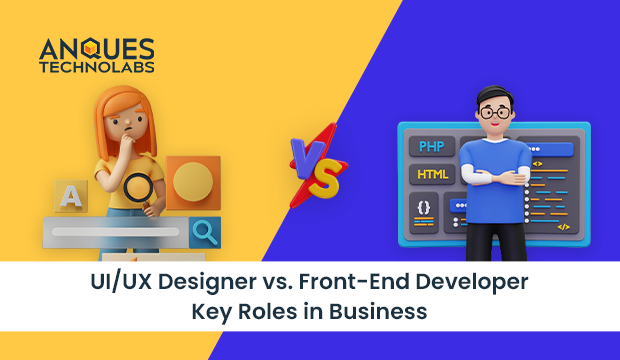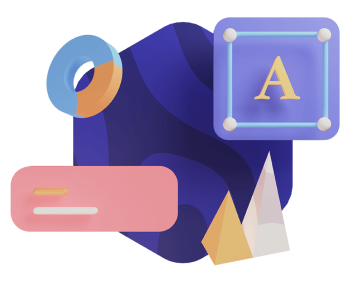Introduction
In today’s competitive online world, businesses aim to create websites and apps that are easy to use, look great, and work well. Two essential roles contributing to these goals are the UI/UX designer vs. front-end developer. While both are integral to delivering a seamless user experience, they bring distinct expertise to a project. Understanding the differences between these roles and how they complement each other is essential for businesses aiming to build a robust digital presence.
This blog guides the unique roles of UI/UX designers and front-end developers, focusing on their skills, responsibilities, and how they work together to create user-friendly designs and functionality.
The Roles of UI/UX Designer and Front-End Developer
What is UI/UX Designer?
UI/UX designers focus on making websites and apps easy to use and visually appealing. “UI” stands for User Interface, which involves designing the look and layout-colors, buttons, and overall style. “UX” stands for User Experience, which is about creating a design that works perfectly. Together, UI and UX design help create digital products that not only look good but also feel intuitive and easy to navigate, providing a smooth and satisfying experience for the user.
What is a Front-End Developer?
Front-end developers make sure the parts of a website or app that users interact with work smoothly. They use programming languages like HTML, CSS, and JavaScript to turn visual designs into functional, clickable elements on the screen. Their job is to create layouts, colors, buttons, and other interactive features while making sure everything looks good and operates correctly across different devices and screen sizes. While designers focus on appearance, front-end developers focus on the technical side to make the user experience smooth and responsive.
Core Responsibilities of a UI/UX Designer
- User Research for Better Design
- Wireframing and Prototyping
- Visual Design and Branding
User Research for Better Design:
UI/UX designers start by understanding the target audience through surveys, interviews, and testing to create a design that meets user needs.
Wireframing and Prototyping:
They create wireframes as blueprints and prototypes to test the design, gather feedback, and make improvements before development.
Visual Design and Branding:
Using design principles like color, typography, and layout, they create an attractive and consistent visual style that aligns with the brand, helping to build trust and recognition.
Core Responsibilities of a Front-End Developer
- Coding and Web Development
- Implementing UI Designs
- Performance Optimization
Coding and Web Development:
Front-end developers use languages like HTML, CSS, and JavaScript to turn designs into working websites or apps, creating structure, style, and interactive features.
Implementing UI Designs:
They integrate visual elements into the code, making sure the design works smoothly and looks great on all devices and screen sizes.
Performance Optimization:
They focus on improving web performance by reducing load times and making interactions smoother, improving the overall user experience.
Key Skills Required for UI/UX Designers
- Design Tools: UI/UX designers use tools like Adobe XD, Figma, and Sketch to create and improve designs, making sure they look good and meet user needs.
- Research Skills: They gather data through user research to understand what users want, making sure designs match user expectations.
- Design Principles: A strong grasp of basics like layout, balance, and contrast helps designers create appealing, easy-to-navigate interfaces.
Key Skills Required for Front-End Developers
- Coding Languages: Front-end developers need to know HTML, CSS, and JavaScript, along with popular frameworks like React or Angular to build interactive websites.
- Responsive Design: They create sites that work well on any device, from desktops to mobile phones, making sure layouts and features adjust smoothly.
- Performance Optimization: They use techniques like image compression and caching to make sites load faster, improving user experience and search engine rankings.
UI/UX Designer vs. Front-End Developer
Approach to User Interaction and Functionality:
UI/UX designers emphasize user interactions and emotional engagement, while front-end developers focus on making these interactions possible through coding. This difference shapes their approach and responsibilities in the design-development process.
Skill Sets and Technical Knowledge:
UI/UX designers are skilled in visual design and user psychology, whereas front-end developers possess technical expertise in programming. This distinction requires businesses to understand which skill set is more relevant to their immediate project needs.
Different Project Phases and Goals:
UI/UX designers are primarily involved in the initial design stages, developing the look and feel of the product. Front-end developers join later to bring the design to life, addressing issues like performance and functionality.
Tools Commonly Used by UI/UX Designers
- Adobe XD, Figma, Sketch
- Prototyping and Wireframing Tools
Adobe XD, Figma, Sketch
UI/UX designers use design platforms like Adobe XD, Figma, and Sketch to create interfaces. These tools provide features for wireframing, prototyping, and collaboration, allowing designers to present their ideas effectively.
Prototyping and Wireframing Tools
In addition to design software, UI/UX designers use wireframing and prototyping tools such as InVision and Balsamiq. These tools aid in visualizing the user flow and testing design concepts before final development.
Tools Commonly Used by Front-End Developers
- HTML, CSS, JavaScript Libraries
- Development Environments and Debugging Tools
HTML, CSS, JavaScript Libraries
Front-end developers rely on core languages like HTML, CSS, and JavaScript to build websites. Libraries and frameworks, such as Bootstrap and React, extend their capabilities, enabling them to create dynamic interfaces.
Development Environments and Debugging Tools
Front-end developers use development environments like Visual Studio Code and debugging tools like Chrome DevTools to streamline coding and troubleshoot issues. These web tools are essential for maintaining code quality and functionality.
Why Do Businesses Need UI/UX Designers?
UI/UX designers are essential for creating digital products that are not only visually appealing but also easy to navigate. By focusing on the user experience, they improve the usability and functionality of websites and apps, making sure that they are intuitive and enjoyable to use.
Businesses need UI/UX designers to improve customer satisfaction, improve user engagement, and boost conversions. A well-designed interface leaves a strong impression, while a thoughtful user experience encourages repeat visits. Ultimately, having skilled UI/UX designers can lead to a more successful product and stronger customer loyalty.
Why Do Businesses Need Front-End Developers?
Front-end developers are essential for turning design concepts into interactive, user-friendly websites and applications. They bring UI/UX designs to life by using coding languages like HTML, CSS, and JavaScript, making sure the product looks great and functions smoothly.
Businesses need front-end developers to create fast, responsive, and visually appealing digital experiences that work across all devices. A skilled front-end developer helps improve user engagement, improve site performance, and boost search engine rankings, making the business’s online presence more effective and successful.
UI/UX Designer or Front-End Developer: Which Do You Need?
Choosing between a UI/UX designer vs. front-end developer depends on the stage of your project and your specific needs. If you want to focus on creating an intuitive, user-friendly experience and appealing design, a UI/UX designer is the right choice. They specialize in understanding user behavior, creating wireframes, and designing interfaces that engage users.
On the other hand, if you already have a design in place and need someone to turn that design into a fully functioning website or app, a front-end developer is essential. They bring designs to life with coding, making sure the product works smoothly and looks great on all devices.
In many cases, both roles are necessary for a successful project, with designers shaping the user experience design and developers building the interactive, responsive features.
Conclusion
UI/UX designers and front-end developers play crucial roles in creating user-friendly, engaging, and functional digital products. Though their responsibilities differ, their combined efforts contribute to a seamless user experience that helps businesses stand out from competitors. To achieve the best results, businesses should recognize the unique value each role offers and invest in a balanced team that strengthens both design and functionality. Anques Technolabs combines the skills of UI/UX designers vs. front-end developers to create digital products that are both visually attractive and easy to use, helping your business succeed.
FAQs
Which is better, UI/UX or front-end developer?
Choosing between UI/UX and front-end development depends on your project needs. UI/UX designers focus on creating an engaging, user-friendly design, while front-end developers turn that design into functional code. Both roles are essential for successful digital products.
What is the difference between a UI developer and a front-end developer?
A UI developer focuses on creating a visually appealing and user-friendly interface, working mainly with design elements. A front-end developer builds the entire user-facing part of a website, making it functional, responsive, and interactive.
Is the UI front-end or backend?
UI is part of the front-end. It involves everything users see and interact with on a website or app, like buttons, layouts, and visuals. The back end handles the data and processes behind the scenes.















